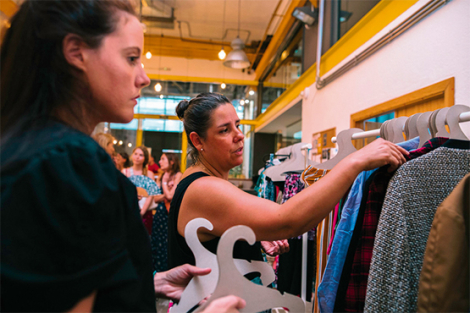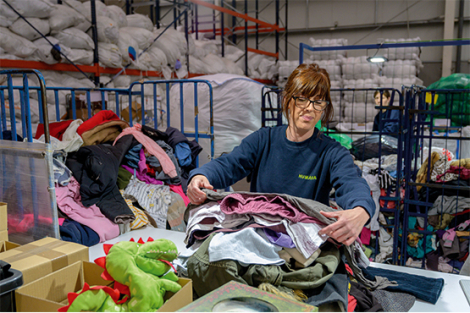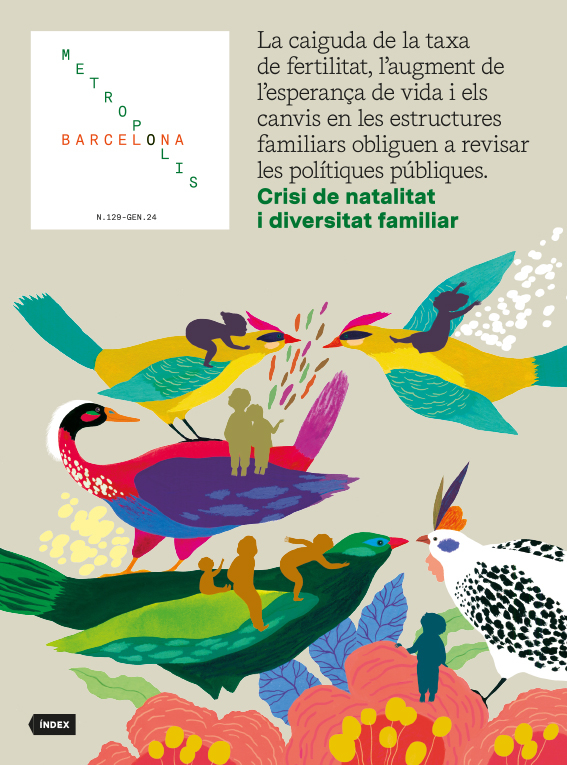The challenge of reducing textile waste and reusing clothes in Barcelona
- Urban visions
- Jan 24
- 10 mins
One of the main concerns of our textile sector today, led by fast fashion, is the amount of waste it produces. Overproduction and overconsumption of garments, which are worn six times on average, are among the fashion industry’s foremost and most apparent environmental impacts. Reuse is now paving the way for the introduction of new concepts and ideas for gaining access to clothing, while helping to transform today’s fashion system.
The current model of linear production and consumption (buy-use-throw away), designed and put in place to grow the North’s economies, has led, through globalisation and the big multinationals in the sector, to the fact that today’s textile value chains are excessively long and lack transparency, resulting in low-cost, substandard products and, primarily, in low levels of safety from the environmental, social and labour points of view. The major chains in the sector have created a production model where product quantity takes precedence over product quality and where the environmental impacts generated in the producing countries, often far from the eyes of consumers, have not been included in the pricing, and above all, labour and social costs have been disregarded: human rights have been violated throughout the entire production chain.
In Catalonia, 166,000 tonnes of textile waste are generated each year, some 21.3 kilograms per inhabitant per year, of which 11% is collected selectively, some 18,270 tonnes. Most of this is sent to waste managers linked to the social economy, but only 5-10% is reintroduced into the country through the sale of second-hand clothing (913.53 tonnes). The remaining domestic textile waste that is collected is divided between three channels. The first corresponds to exporting the waste (60-70%) to African countries, Pakistan and some European and South American countries. The second is recovery through material recycling, which accounts for 20-30%; it is often also sent to Pakistan. The third channel, which includes whatever is no longer usable (the remaining 5-10%), is managed through energy recovery or disposal. It should be borne in mind that 89% of textile waste (147,240.24 tonnes) is not collected selectively because it is not sorted and is thrown into the wrong waste bins. Therefore, it cannot be recovered and ultimately amounts to a very substantial cost and environmental impact at the local level.[1].
 Fashion Pills is a bi-monthly clothing exchange event organised by Moda Sostenible Barcelona, accompanied by talks on various topics. © Virginia D., Enero Films. Impact Hub Barcelona. Moda Sostenible Barcelona.
Fashion Pills is a bi-monthly clothing exchange event organised by Moda Sostenible Barcelona, accompanied by talks on various topics. © Virginia D., Enero Films. Impact Hub Barcelona. Moda Sostenible Barcelona.An extractivist and exploitative model
Today, this extractivist and exploitative production-consumption model is the focus of the new policies being rolled out in Europe in the framework of the European Green Deal[2], strategic documents such as the Circular Economy Action Plan[3] and the new European Industrial Strategy[4] and, in particular, the EU Strategy for Sustainable and Circular Textiles,[5], which aims to make Europe the first low-carbon and circular economy territory by 2050. The new directives created under this strategy – the waste directive, currently already transposed into the Spanish Waste Law[6], and the Ecodesign Directive[7], which is being revised, among others – will completely transform the textile and fashion industry with a clear objective: to replace the current linear production model with a future model linked to the circular economy.
The circular economy aims to reduce resource consumption and waste generation. It is based on the principle of doing more with less, and on the idea that products, materials and resources can be used and reused for as long as possible. This circular model is in direct opposition to the classical model applied by traditional industry based on extraction, production, consumption and waste.
Strategies must be applied to enable new circuits and synergies must be established between all agents in the value chain, from producers to consumers, including distributors, government bodies and so on. In the textile industry, this means minimising the use of virgin raw materials; recovering as many resources and components as possible; ensuring that production is carried out in accordance with the principles of safe chemistry and mono-materiality; creating circuits for the recovery, repair and resale of products; promoting local policies that encourage material recirculation, etc. A whole series of variables that make it possible to create a textile system where the concept of waste fades out and is transformed into a resource.
Extending the life of garments reduces the extraction of virgin materials and the emissions associated with production.
In this framework, one of the main strategies is reuse, which extends the life of garments. Therefore, a demand is met with a product that has already been produced, thus reducing the demand for the extraction of new virgin raw materials and reducing the emissions generated in production. Furthermore, through this recirculation, new jobs can be created that are involved in the processes of recovery, collection, sorting, preparation for reuse and sale of the material. New business opportunities can also be opened up through this management and recirculation of the material flow.
Reuse as a tool for prevention
The city of Barcelona is home to several initiatives and action plans that contribute to this shift towards a circular model. Firstly, second-hand clothes shops run by social economy organisations, which are generally linked to waste managers, companies that collect textile waste at municipal level, either through the well-known orange/red/green containers (the colour varies from company to company) or through door-to-door collection, in line with the municipal collection scheme. Some examples of these shops are the secondary co-operative Roba Amiga, comprising Solidança, Formació i Treball, Engrunes, Tapís and Andròmines; other similar companies, such as Moda re- and Beyondwear, set up by Cáritas and the Formació i Treball group, and the company Humana Spain, among others. The distinctive feature that sets these companies apart is that they use second-hand textile products to promote integration into the labour market. Therefore, by managing textile waste, they generate employment for disadvantaged groups.
Secondly, privately run shops and private sector entrepreneurs. The garments they resell are often sourced from large distributors of second-hand clothing that they then pass off as vintage. We find shops where entrepreneurs search and rummage through various wholesale markets to offer a particular style of clothing, such as Flamingos. More examples in Barcelona include cottonVintage, Le Swing Vintage, Holala Ibiza, Lullaby, Neko Vintage, La Principal Retro & Co, Love Vintage, TurQuesh, Ven-t’ho, Alabama Collect and L’Arca Barcelona, among others.
There are also some fashion brands and retailers that promote circularity: from encouraging customers to hand in clothes they no longer wear in exchange for a discount on future purchases, to offering both online and on-site spaces for their brand’s second-hand garments. Examples of this model are brands such as Nudie Jeans and large groups such as Levi’s, Mango, Inditex and H&M, among others, which are seeking methods of this kind with a view to becoming the new retailers of second-hand clothing.
 Sorting of clothes at the preparation plant for reuse by Humana, located in L’Ametlla del Vallès. © Humana Fundación Pueblo para Pueblo
Sorting of clothes at the preparation plant for reuse by Humana, located in L’Ametlla del Vallès. © Humana Fundación Pueblo para PuebloFinally, second-hand markets, traditionally known as flea markets, also offer clothing. The most well-known and popular in the city are Fleadonia (Flea Market), in the Raval neighbourhood, and Lost&Found, in Plaça del Mar [in the Barceloneta neighbourhood]. The distinctive feature of these two markets is that it is private individuals who offer their clothes for sale, with no intermediaries, and the sale is made directly between one individual and another. Moreover, the city also boasts the historic Mercat dels Encants, with several stalls dedicated to the sale of second-hand clothes.
The huge capacity for online sales
A second major set of new proposals or new business models are online platforms, which have a wider reach, as well as the capacity to reach many users and manage a large amount of clothing. There are different business models, such as widespread second-hand clothing sales platforms, which handle large volumes from individuals, companies or even textile waste managers. In this case, the company oversees all the management and collection of the textile waste, assessing its usability, sanitising it and preparing it so that it can be uploaded to the second-hand sale website. An example of this type of business model is Micolet. There are also platforms that act as facilitating agents that put sellers, in this case individuals, in contact with buyers, as is the case of Vinted.
Clothing rental platforms are a third model, ranging from platforms that rent clothes from various brands to others that aim to become managers of their private users’ wardrobes. One example is Ecodicta.
And there is yet another system, based on the exchange of products between users. Swap parties are gaining ground and are emerging with a two-fold objective: raising consumer awareness of the textile issue and extending the useful life of the clothes in people’s wardrobes. Some examples of swap parties are those organised by the association Moda Sostenible Barcelona. And another initiative is the one promoted by Barcelona City Council, “Renew your wardrobe”[8], with the aim of fostering exchange, responsible consumption and awareness of textile waste. The network currently has 27 points throughout the city that host these exchanges, promoted by the city council, twice a year.
A long road ahead
The options for accessing second-hand clothing are growing and reaching more kinds of consumers. This is the result of both greater consumer awareness and an increase in the information linked to the environmental and social impacts of fashion. Technology also plays a significant role, facilitating new channels of communication and exchange. However, there is still a long road ahead.
There is greater consumer awareness and an increase in the information linked to the environmental and social impacts of fashion.
Circularity is a holistic model proposal, where all agents play a key role. To this end, and to help drive textile circularity in Catalonia, the Government of Catalonia’s Office for Climate Change and the Waste Agency of Catalonia have launched and promoted the Pact for Circular Fashion[9], a Catalonia-based tool that connects all the agents in the textile chain: fashion brands, textile manufacturers, waste management companies, recyclers, local government and business associations linked to the textile industry. The pact sets out several specific objectives for each link in the chain, facilitates their synergies to create projects that boost circularity and fosters their communication to better identify the joint challenges to move towards the circular model. Circularity and its promotion strategies are a common challenge shared by all the agents that make up the sector, from producers to consumers/users, including state, autonomous community and local administrations, and associations and organisations in the sector.
These proposals exemplify how reuse, together with new communication technologies, have paved the way for the creation and generation of future business opportunities. Reuse wholly transforms the buying and selling model. Therefore, the profound change it brings about is directly related to uses, which means that we are moving from being consumers to being users of a resource. In this case, of the clothes that clothe us.
[1] Waste Agency of Catalonia. via.bcn/R9Nf50Q2wb8
[2] The European Green Deal. via.bcn/Birp50Q5QzU
[3] European Commission. Circular Economy Action Plan. via.bcn/AXxP50Q2woN
[4] European Commission. European Industrial Strategy. via.bcn/VpzL50Q5SbK
[5] EU Strategy for Sustainable and Circular Textiles via.bcn/ElO950Q2wsi
[6] Eco-Design Directive. via.bcn/x2Rx50Q2wVp
[7] State Waste Law via.bcn/kpSp50Q2wX4
[8] Barcelona City Council’s “Renew your wardrobe” initiative. via.bcn/GiJX50Q2xp8
[9] Pact for Circular Fashion via.bcn/qRZQ50Q2xto
The newsletter
Subscribe to our newsletter to keep up to date with Barcelona Metròpolis' new developments




